高财第12章习题
高财第12章习题汇总
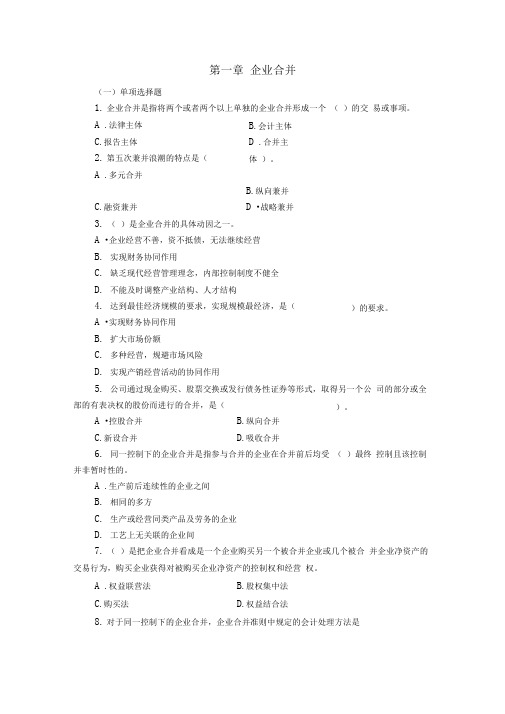
1.为甲公司编制合并业务的会计分录。
2.为乙公司编制注销业务的会计分录。
练习二
一、目的:掌握非同一控制下合并方以发行权益性证券作为合并对价的控 股合并的会计处理。
二、资料:仍然延用练习一所提供的资料,但把对价形式改为:甲公司发行 了每股面值1元(每股市价5元)的股票2000000股,换取乙公司股东持有的每 股面值1元的股票6000000股。
还发生了合并业务直接相关的费用56000元。合并时乙公司经确认的资产负债表 见图表如下:
资产
账面金额
公允价值
负债及所有者权益
账面金额
公允价值
银行存款
260000
260000
短期借款
550000
550000
应收账款(净)
580000
540000
应付账款
540000
540000
存货
920000
970000
15.非同一控制下企业合并中发生的与企业合并直接相关的费用包括与为进
行企业合并发行的权益性证券或发行的债务相关的手续费、佣金。
业务题
练习一
一、目的:掌握非同一控制下合并方以支付现金、 务方式作为合并对价的控股合并的会计处理。
二、资料:甲、乙公司属非同一控制的两家公司, 公司吸收合并乙公司,两公司会计事项的处理原则相同, 合并时,甲公司以银行存款9800000元,取得乙公司
有者权益的账面价值为1000万元,可辨认净资产公允价值为1300万元。则A公司在合并日的会计处理中,正确的是( 应确认资本公积——资本溢价70万元 应确认资本公积——其他资本公积70万元 应确认资本公积——其他资本公积95万元 确认的资本公积金额应在会计科目借方
高财-课后练习及答案
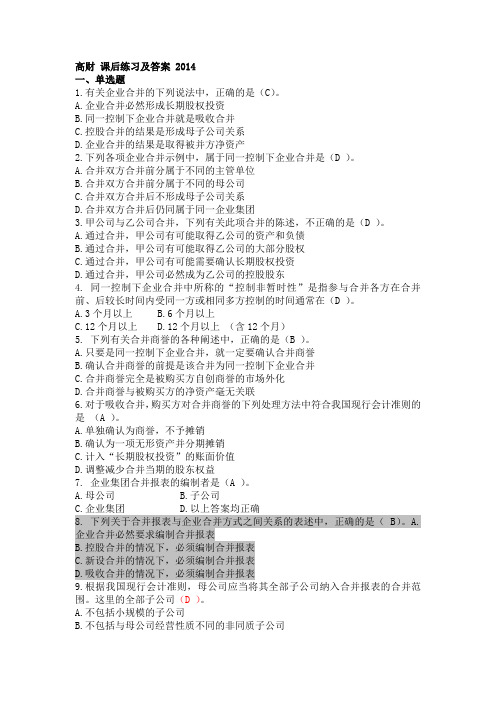
高财课后练习及答案 2014一、单选题1.有关企业合并的下列说法中,正确的是(C)。
A.企业合并必然形成长期股权投资B.同一控制下企业合并就是吸收合并C.控股合并的结果是形成母子公司关系D.企业合并的结果是取得被并方净资产2.下列各项企业合并示例中,属于同一控制下企业合并是(D )。
A.合并双方合并前分属于不同的主管单位B.合并双方合并前分属于不同的母公司C.合并双方合并后不形成母子公司关系D.合并双方合并后仍同属于同一企业集团3.甲公司与乙公司合并,下列有关此项合并的陈述,不正确的是(D )。
A.通过合并,甲公司有可能取得乙公司的资产和负债B.通过合并,甲公司有可能取得乙公司的大部分股权C.通过合并,甲公司有可能需要确认长期股权投资D.通过合并,甲公司必然成为乙公司的控股股东4. 同一控制下企业合并中所称的“控制非暂时性”是指参与合并各方在合并前、后较长时间内受同一方或相同多方控制的时间通常在(D )。
A.3个月以上B.6个月以上C.12个月以上D.12个月以上(含12个月)5. 下列有关合并商誉的各种阐述中,正确的是(B )。
A.只要是同一控制下企业合并,就一定要确认合并商誉B.确认合并商誉的前提是该合并为同一控制下企业合并C.合并商誉完全是被购买方自创商誉的市场外化D.合并商誉与被购买方的净资产毫无关联6.对于吸收合并,购买方对合并商誉的下列处理方法中符合我国现行会计准则的是(A )。
A.单独确认为商誉,不予摊销B.确认为一项无形资产并分期摊销C.计入“长期股权投资”的账面价值D.调整减少合并当期的股东权益7. 企业集团合并报表的编制者是(A )。
A.母公司B.子公司C.企业集团D.以上答案均正确8. 下列关于合并报表与企业合并方式之间关系的表述中,正确的是( B)。
A.企业合并必然要求编制合并报表B.控股合并的情况下,必须编制合并报表C.新设合并的情况下,必须编制合并报表D.吸收合并的情况下,必须编制合并报表9.根据我国现行会计准则,母公司应当将其全部子公司纳入合并报表的合并范围。
人大高财课后练习答案
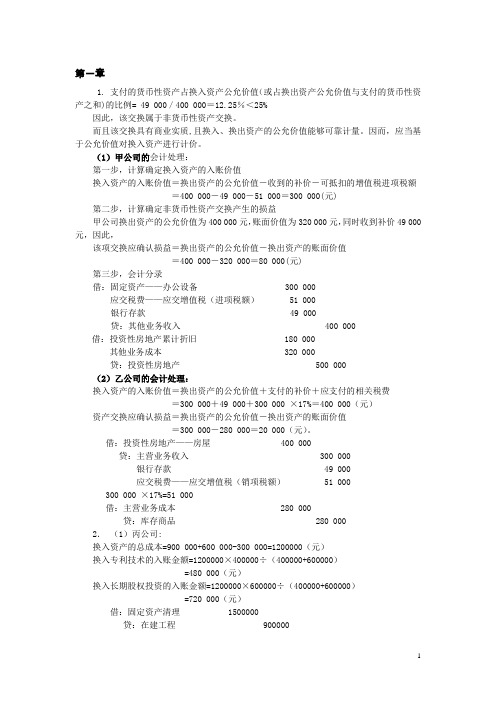
第一章1.支付的货币性资产占换入资产公允价值(或占换出资产公允价值与支付的货币性资产之和)的比例= 49 000/400 000=12.25%<25%因此,该交换属于非货币性资产交换。
而且该交换具有商业实质,且换入、换出资产的公允价值能够可靠计量。
因而,应当基于公允价值对换入资产进行计价。
(1)甲公司的会计处理:第一步,计算确定换入资产的入账价值换入资产的入账价值=换出资产的公允价值-收到的补价-可抵扣的增值税进项税额=400 000-49 000-51 000=300 000(元)第二步,计算确定非货币性资产交换产生的损益甲公司换出资产的公允价值为400 000元,账面价值为320 000元,同时收到补价49 000元,因此,该项交换应确认损益=换出资产的公允价值-换出资产的账面价值=400 000-320 000=80 000(元)第三步,会计分录借:固定资产——办公设备 300 000应交税费——应交增值税(进项税额) 51 000银行存款 49 000贷:其他业务收入 400 000 借:投资性房地产累计折旧 180 000其他业务成本 320 000贷:投资性房地产 500 000 (2)乙公司的会计处理:换入资产的入账价值=换出资产的公允价值+支付的补价+应支付的相关税费=300 000+49 000+300 000 ×17%=400 000(元)资产交换应确认损益=换出资产的公允价值-换出资产的账面价值=300 000-280 000=20 000(元)。
借:投资性房地产——房屋 400 000贷:主营业务收入 300 000银行存款 49 000应交税费——应交增值税(销项税额) 51 000 300 000 ×17%=51 000借:主营业务成本 280 000贷:库存商品 280 0002.(1)丙公司:换入资产的总成本=900 000+600 000-300 000=1200000(元)换入专利技术的入账金额=1200000×400000÷(400000+600000)=480 000(元)换入长期股权投资的入账金额=1200000×600000÷(400000+600000)=720 000(元)借:固定资产清理 1500000贷:在建工程 900000固定资产 600000借:无形资产——专利技术 480000长期股权投资 720000银行存款 300000贷:固定资产清理 1500000(2)丁公司:换入资产的总成本=400 000+600 000+300 000=1300000(元)换入办公楼的入账金额=1300000×900000÷(900000+600000) =780 000(元)换入办公设备的入账金额=1300000×600000÷(900000+600000) =520 000(元)借:在建工程——办公楼 780000固定资产——办公设备 520000贷:无形资产——专利技术 400000长期股投资 600000银行存款 300000第二章1.(1)甲公司的会计分录。
高级财务会计课后练习答案
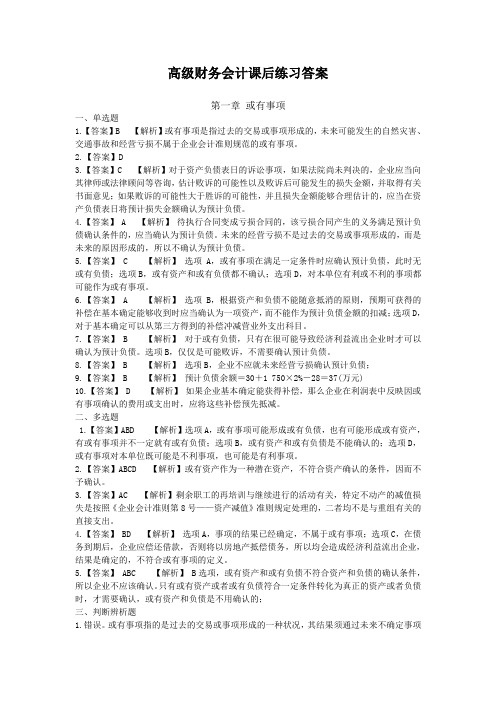
高级财务会计课后练习答案第一章或有事项一、单选题1.【答案】B 【解析】或有事项是指过去的交易或事项形成的,未来可能发生的自然灾害、交通事故和经营亏损不属于企业会计准则规范的或有事项。
2.【答案】D3.【答案】C 【解析】对于资产负债表日的诉讼事项,如果法院尚未判决的,企业应当向其律师或法律顾问等咨询,估计败诉的可能性以及败诉后可能发生的损失金额,并取得有关书面意见;如果败诉的可能性大于胜诉的可能性,并且损失金额能够合理估计的,应当在资产负债表日将预计损失金额确认为预计负债。
4.【答案】 A 【解析】待执行合同变成亏损合同的,该亏损合同产生的义务满足预计负债确认条件的,应当确认为预计负债。
未来的经营亏损不是过去的交易或事项形成的,而是未来的原因形成的,所以不确认为预计负债。
5.【答案】 C 【解析】选项A,或有事项在满足一定条件时应确认预计负债,此时无或有负债;选项B,或有资产和或有负债都不确认;选项D,对本单位有利或不利的事项都可能作为或有事项。
6.【答案】 A 【解析】选项B,根据资产和负债不能随意抵消的原则,预期可获得的补偿在基本确定能够收到时应当确认为一项资产,而不能作为预计负债金额的扣减;选项D,对于基本确定可以从第三方得到的补偿冲减营业外支出科目。
7.【答案】 B 【解析】对于或有负债,只有在很可能导致经济利益流出企业时才可以确认为预计负债。
选项B,仅仅是可能败诉,不需要确认预计负债。
8.【答案】 B 【解析】选项B,企业不应就未来经营亏损确认预计负债;9.【答案】 B 【解析】预计负债余额=30+1 750×2%-28=37(万元)10.【答案】 D 【解析】如果企业基本确定能获得补偿,那么企业在利润表中反映因或有事项确认的费用或支出时,应将这些补偿预先抵减。
二、多选题1.【答案】ABD 【解析】选项A,或有事项可能形成或有负债,也有可能形成或有资产,有或有事项并不一定就有或有负债;选项B,或有资产和或有负债是不能确认的;选项D,或有事项对本单位既可能是不利事项,也可能是有利事项。
高级财务会计课后习题答案(仅供参考)(1)
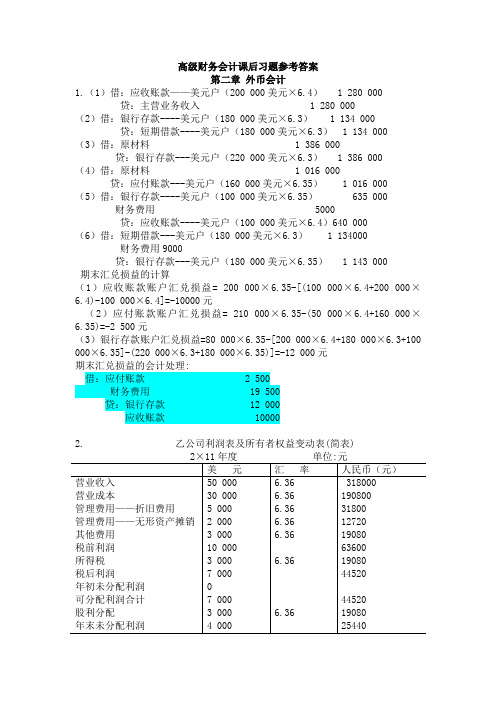
高级财务会计课后习题参考答案第二章外币会计1.(1)借:应收账款——美元户(200 000美元×6.4) 1 280 000贷:主营业务收入 1 280 000(2)借:银行存款----美元户(180 000美元×6.3) 1 134 000贷:短期借款----美元户(180 000美元×6.3) 1 134 000(3)借:原材料 1 386 000贷:银行存款---美元户(220 000美元×6.3) 1 386 000(4)借:原材料 1 016 000贷:应付账款---美元户(160 000美元×6.35) 1 016 000(5)借:银行存款----美元户(100 000美元×6.35) 635 000 财务费用 5000贷:应收账款----美元户(100 000美元×6.4)640 000(6)借:短期借款---美元户(180 000美元×6.3) 1 134000财务费用9000贷:银行存款---美元户(180 000美元×6.35) 1 143 000期末汇兑损益的计算(1)应收账款账户汇兑损益= 200 000×6.35-[(100 000×6.4+200 000×6.4)-100 000×6.4]=-10000元(2)应付账款账户汇兑损益= 210 000×6.35-(50 000×6.4+160 000×6.35)=-2 500元(3)银行存款账户汇兑损益=80 000×6.35-[200 000×6.4+180 000×6.3+100 000×6.35]-(220 000×6.3+180 000×6.35)]=-12 000元期末汇兑损益的会计处理:借:应付账款 2 500财务费用 19 500贷:银行存款 12 000应收账款 100002. 乙公司利润表及所有者权益变动表(简表)乙公司资产负债表1.(1)①机床的2011年12月31日的账面价值为110万元;该项机床的计税基础应当是90万元(原值120万元减去计税累计折旧30万元)。
高财习题一到五章题目+答案

第一章【例1-1】国内甲公司的记账本位币为人民币。
2007年6月5日,向国外乙公司出口销售商品一批,根据销售合同,货款共计100 000美元,当日的即期汇率为1美元=8.1元人民币。
假定不考虑增值税等相关税费,货款尚未收到。
甲公司应作如下账务处理借:应收账款—美元(100 000×8.1)810 000贷:主营业务收入(100 000×8.1)810 000【例1-2】国内某公司的记账本位币为人民币,属于增值税一般纳税企业。
2007年4月10日,从国外购入某原材料,共计50 000欧元,当日的即期汇率为1欧元=10元人民币,按照规定计算应缴纳的进口关税为50 000元人民币,支付的进口增值税为85 000元人民币,货款尚未支付,进口关税及增值税已用银行存款支付。
该公司相关账务处理如下:借:原材料(50 000×10+50 000)550 000应交税费—应交增值税(进项税额)85 000贷:应付账款—欧元500 000银行存款(50 000+85 000)135 000【例1-3】国内某企业的记账本位币是人民币。
2007年5月12日从中国银行借入英镑10 000元,期限为6个月,年利率为6%,当日的即期汇率为1英镑=12元人民币。
假定借入的英镑暂存银行。
该企业的相关账务处理如下:借:银行存款—英镑(10 000×12)120 000贷:短期借款—英镑l20 000【例1-4】国内甲公司的记账本位币为人民币。
2007年l2月12日,甲公司与某外商签订投资合同,当日收到外商投入资本20 000美元,当日的即期汇率为l美元=8.15元人民币,假定投资合同约定的汇率为1美元=8.2元人民币。
甲公司应进行以下账务处理:借:银行存款—美元(20 000×8.15)163 000贷:实收资本l63 000【例1-5】沿用【例1-1】,假定2007年6月30日的即期汇率为1美元=8.2元人民币,则对该笔交易产生的外币货币性项目“应收账款”,采用期末汇率折算为记账本位币820 000元人民币(100 000×8.2),与其交易日折算为记账本位币时的金额810 000元人民币的差额为10 000元人民币,应当计入当期损益,同时调整货币性项目的原记账本位币金额。
高财业务题答案

《高级财务会计》练习册答案第一章合伙企业会计一、名解略二、单选1.B2.A3.A4.B5.C6.B7.C8. B三、多选1.AD2.ABD3.BCD4.ABC5.BC6.ABCD7.CD8.ABCD四、判断1.×2. ×3. ×4. ×5. ×6.√7. √8. ×五、简答略六、业务1、(1)投资净额法借:银行存款60000存货20000固定资产—设备30000—房屋120000贷:长期借款50000合伙人资本—甲80000合伙人资本—乙100000(2)红利法借:银行存款60000存货20000固定资产—设备30000—房屋120000贷:长期借款50000合伙人资本—甲90000合伙人资本—乙90000(3)商誉法借:银行存款60000存货20000固定资产—设备30000—房屋120000商誉20000贷:长期借款50000合伙人资本—甲100000合伙人资本—乙1000002、(1)按加权平均资本余额分配张三= 20000×3/12+22000×5/12+25000×4/12=22500(元)李四=20000×6/12+15000×3/12+11000×3/12=16500(元)张三=100000×(22500/39000)=57692.31(元)李四=100000 ×(16500/39000)=42307.69(元)(2)借:本年利润100 000贷:合伙人资本—张三57692.31—李四42307.63、(1)红利法新合伙企业的资本总额=8000+4000=12000甲转让给丙的资本额=8000-(8000+4000)×30%=4400元乙转让给丙的资本额=4000-(8000+4000)×20%=1600元借:合伙人资本—甲4400—乙1600贷:合伙人资本—丙6000(2)商誉法新合伙企业的资本总额=4000×2÷50%=16000元商誉=16000-12000=4000元借:商誉4000贷:合伙人资本—甲2400—乙1600甲转让给丙的资本额=(8000+2400)-(8000+4000+4000)×30%=5600元乙转让给丙的资本额=(4000+1600)-(8000+4000+4000)×20%=2400元借:合伙人资本—甲5600—乙2400贷:合伙人资本—丙80004、(1)借:合伙人资本—甲45600—乙30400贷:合伙人资本—丙76000(2)借:现金72000贷:合伙人资本—丙72000借:商誉60000贷:合伙人资本—甲36000—乙24000(3)借:现金52000合伙人资本—甲2400—乙1600贷:合伙人资本—丙560005、(1)红利法借:合伙人资本—甲12000—乙100000—丙8000贷: 现金120000(2)商誉部分确认法商誉=退付现金—退伙人资本余额=12-10=2(万元) 借:商誉20000贷:合伙人资本—B 20000借: 合伙人资本—B 120000贷:现金120000(3)商誉全部确认法商誉=2÷1/3=2×3=6(万元),甲、乙、丙各自得到3万元.2万元.1万元.借:商誉60000贷:合伙人资本—甲30000—乙20000—丙10000借: 合伙人资本—乙120000贷:现金1200006、(1)借:现金50000合伙人资本—甲7000—乙3000贷:存货60000(2)借:现金60000合伙人资本—甲14000—乙6000贷:固定资产(净值)80000(3)借:现金44000合伙人资本—甲11200—乙4800贷:应收账款(净额)60000(4)借:应付账款80000贷:现金80000(5)借:应付合伙人借款—甲20000贷:现金20000(6)借:合伙人资本—甲17800—乙56200贷:现金74000第二章分支机构会计一、名解略二、单选1.D2.C3.B4.D5.D6.A7.D8.B9.D 10.B三、多选1.BCDE2.ABDE3.AB4.BCDE5.AB6.ABC7.CDE8.ADE9.ACDE 10.ABCDE四、判断1.×2. ×3. ×4. ×5. √6. ×7. √8. √9. √ 10. ×五、简答略六、业务1、总公司分支机构借:分支机构往来40 借:库存商品30贷:库存商品30 银行存款10 银行存款10 贷:总公司往来40 借:分支机构往来20 借:固定资产20 贷:银行存款20 贷:总公司往来20借:营业费用 4贷:累计折旧 4借:银行存款35贷:主营业务收入35借:主营业务成本20贷:库存商品20借:营业费用 2贷:银行存款 2 借:营业费用18贷:银行存款18借:分支机构往来 1 借:营业费用 1贷:营业费用 1 贷:总公司往来 1 借:银行存款27 借:总公司往来27贷:分支机构往来27 贷:银行存款27联合报表的抵销分录:借:总公司往来34贷:分支机构往来34结账分录:借:分支机构往来22 借:主营业务收入35贷:本年利润——分支机构转入22 贷:营业费用 3主营业务成本20总公司往来222、总公司分支机构借;分支机构往来120 借:库存商品120贷:库存商品100 贷:总公司往来120存货加价20与内部交易相关的抵销分录:借:存货加价20贷:主营业务成本16存货 43、总公司:分支机构:借:分支机构往来60 借:库存商品60贷:库存商品50 贷:总公司往来60 存货加价10联合报表抵消分录:借:存货加价18贷:存货 4主营业务成本14总公司结账时确认存货已实现利润:借:存货加价14贷:本年利润144、总公司分支机构:借:分支机构往来8 借:银行存款8贷:银行存款8 贷:总公司往来8借:分支机构往来22 借:库存商品22贷:库存商品20 贷:总公司往来22 存货加价2借:固定资产 5 借:总公司往来 5贷:分支机构往来 5 贷:银行存款 5借:分支机构往来 1 借:营业费用 1贷:累计折旧 1 贷:总公司往来 1借:库存商品 2贷:银行存款 2借:营业费用 1贷:银行存款 1借:银行存款32贷:主营业务收入32借:主营业务成本21.8贷:库存商品21.8 借:银行存款18 借:总公司往来18借:分支机构往来8.2 借:主营业务收入32 贷:本年利润8.2 贷:主营业务成本21.8营业费用 2总公司往来8.2 借:存货加价1.8贷:本年利润 1.8第三章企业合并一、名解略二、单选勘误:第31页单选第1题,题目改为:企业合并中不属于法律形式的合并为1.D2.A3.A4.B5.B6.C7.A8.D9.A 10.C三、多选1.AD2.AD3.BD4.AB5.ABD四、判断1.×2. ×3. ×4. ×5. ×6. ×7. ×8. √9. √ 10. √五、简答略六、业务1. 同一控制下的企业合并①借:银行存款10应收账款30存货40土地10固定资产110资本公积40贷:应付账款20应付票据30银行存款190②借:银行存款10应收账款30存货40土地10固定资产110贷:应付账款20应付票据30银行存款30股本100资本公积20③借:银行存款10应收账款30存货40土地10固定资产110贷:应付账款20应付票据30应付债券130资本公积20非同一控制下的企业合并①借:银行存款10应收账款28存货50土地20固定资产130贷:应付账款20应付票据28银行存款190②商誉=(30+100×2)-190=40万借:银行存款10应收账款28存货50土地20固定资产130商誉40贷:应付账款20应付票据28银行存款30股本100资本公积100③借:银行存款10应收账款28存货50土地20固定资产130贷:应付账款20应付票据28应付债券130营业外收入60 2.(1)借:长期股权投资10000贷:股本1000资本公积9000(2)借:存货1000长期股权投资500固定资产1500无形资产1000实收资本6000资本公积2000盈余公积300未分配利润2700商誉1000贷:长期股权投资10000少数股权投资6000(4)借:银行存款200应收账款800库存商品5000长期股权投资1500固定资产9500无形资产2000商誉1000贷:短期借款2000应付账款1000其他应付款1000股本1600资本公积14400第四章合并财务报表(上)一、名解略二、单选1.D2.C3.B4.B5.D6.A7.A8.B9.C 10.D三、多选1.ABD2.ABC3.AC4.ABCD5.ABC6.ABC7.ACD8.ACD9.ACD 10.AD四、判断1.√2. ×3. ×4. √5. √6. ×7. √8. ×9. √ 10. ×五、简答略六、业务1.①借:固定资产——办公楼200贷:资本公积——其他资本公积200②借:管理费用20贷:固定资产——累计折旧20③借:长期股权投资——S公司228贷:投资收益——S公司228④借:股本2000资本公积900盈余公积800未分配利润480商誉520贷:长期股权投资3028少数股东权益l672⑤借:投资收益948少数股东损益632未分配利润一年初400贷:本年利润分配一提取盈余公积300本年利润分配一应付股利1200未分配利润—年末4802.(学生必须写得很小,否则空白不够)(1)借:长期股权投资8000资本公积200贷:银行存款8200借:应收股利400贷:长期股权投资400借:银行存款400贷:应收股利400借:应收股利320长期股权投资400贷:投资收益720借:银行存款320贷:应收股利320(2)×7年12月31日按权益法调整后的长期股权投资账面余额=8000+1000×80%-500×80%=8400万元×8年12月31日按权益法调整后的长期股权投资账面余额=8000+1000×80%-500×80%+1200×80%-400×80%=9040万元(3)×7年×8年借:股本 6000 6000资本公积—年初 1000 1000盈余公积—年初 300 400—本年 100 120未分配利润—年末 3100 3780 贷:长期股权投资 8400 9040少数股权投资 2100 2260借:投资收益 800 960少数股东损益 200 240未分配利润—年初 2700 3100贷:提取盈余公积 100 120对所有者的分配 500 400未分配利润—年末 3100 37803.(学生必须写得很小,否则空白不够)(1)借:长期股权投资33000贷:银行存款33000借:应收股利800贷:长期股权投资800借:银行存款800贷:应收股利800借:应收股利880贷:长期股权投资880借:银行存款880贷:应收股利880(2)×7年12月31日按权益法调整后的长期股权投资账面余额=33000+4000×80%-1000×80%=35400万元×8年12月31日按权益法调整后的长期股权投资账面余额=33000+4000×80%-1000×80%+5000×80%-1100×80%=38520万元(3)×7年×8年借:股本 30000 30000资本公积—年初 2000 2000盈余公积—年初 800 1200—本年 400 500未分配利润—年末 9800 13200商誉 1000 1000 贷:长期股权投资 35400 38520 少数股权投资 8600 9380借:投资收益 3200 4000少数股东损益 800 1000未分配利润—年初 7200 9800贷:提取盈余公积 400 500对所有者的分配 1000 1100未分配利润—年末9800 13200第五章合并财务报表(下)一、单选1.C2.B3.B4.D5.D6.C7.D8.D9.D 10.C二、多选1.BC2.ABCD3.AB4.ABCD5.BC三、简答略四、业务1.参考答案:(1)2006年度该设备相关的合并抵销分录该机器不含增值税价格=192/1.17=164.1固定资产原价中包含的内部销售利润=164.1-144=20.1万元2006年度多提折旧=20.1÷4÷2=2.51万元借:营业收入 164.1贷:营业成本 144固定资产原价20.1借:固定资产——累计折旧 2.5l贷:管理费用 2.5l(2)2007年度该设备相关的合并抵销分录借:未分配利润——年初20.1贷:固定资产 20.1借:固定资产——累计折旧 2.51贷:未分配利润——年初 2.5l借:累计折旧 5.03贷:管理费用 5.03(3)2008年度该设备相关的抵销分录借:未分配利润——年初 20.1贷:营业外收入20.1借:营业外收入 7.54贷:未分配利润——年初 7.54借:营业外收入 3.35贷:管理费用 3.352.(1)借:未分配利润——年初 60 000贷:营业成本 60 000借:营业收入 1 000 000贷:营业成本 1 000 000(2)借:未分配利润——年初 72 000 贷:营业成本 72 000借:未分配利润——年初 18 000 贷:存货 18 000借:营业收入 1 200 000贷:营业成本 1 200 000借:营业收入 800 000贷:营业成本 640 000存货 160 0003.(1)借:应付股利 30 000贷:应收股利30 000(2)借:应收账款——坏账准备 250贷:未分配利润——年初 250借:应付账款 60 000贷:应收账款 60 000 借:应收账款——坏账准备50贷:资产减值损失50 (3)借:应付票据 100 000 贷:应收票据 100 000 (4)借:应付债券114 000 贷:持有至到期投资 114 000借:投资收益 6 000贷:财务费用 6 0004.(1)抵消甲公司持有的乙公司债券本金和利息借:应付债券324 000贷:持有至到期投资324 000 (2)借:营业收入100 000贷:营业成本100 000借:营业成本 6 000贷:存货 6 000借:应付账款100 000贷:应收账款 100 000 (3)借:营业收入 5 000 000 贷:营业成本 3 000 000固定资产 2 000 000借:固定资产——累计折旧 100 000贷:管理费用 100 000(4)抵消内部债券交易的利息借:投资收益 24 000贷:财务费用 24 000(5)借:应收账款——坏账准备 5 000 贷:资产减值损失 5 0005.(1)抵销期初存货中未实现的内部销售利润。
《高级财务会计》课后习题参考答案人大完整版
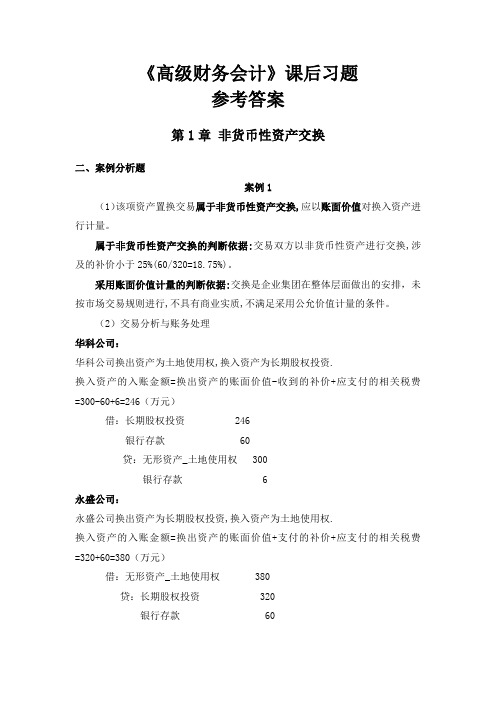
《高级财务会计》课后习题参考答案第1章非货币性资产交换二、案例分析题案例1(1)该项资产置换交易属于非货币性资产交换,应以账面价值对换入资产进行计量。
属于非货币性资产交换的判断依据:交易双方以非货币性资产进行交换,涉及的补价小于25%(60/320=18.75%)。
采用账面价值计量的判断依据:交换是企业集团在整体层面做出的安排,未按市场交易规则进行,不具有商业实质,不满足采用公允价值计量的条件。
(2)交易分析与账务处理华科公司:华科公司换出资产为土地使用权,换入资产为长期股权投资.换入资产的入账金额=换出资产的账面价值-收到的补价+应支付的相关税费=300-60+6=246(万元)借:长期股权投资 246银行存款 60贷:无形资产_土地使用权 300银行存款 6永盛公司:永盛公司换出资产为长期股权投资,换入资产为土地使用权.换入资产的入账金额=换出资产的账面价值+支付的补价+应支付的相关税费=320+60=380(万元)借:无形资产_土地使用权 380贷:长期股权投资 320银行存款 60案例2和顺公司:换入资产入账金额=换出资产公允价值之和-收到的补价+应支付的相关税费=610-30+(150*17%-350*17%)=546(万元)原材料(棉布)分摊率=350/(350+230)=0.6034棉布分摊价值=546*0.6034=329.46固定资产分摊率=230/(350+230)=0.3966固定资产(厂房)入账价值=546*0.3966=216.54借:原材料-棉布 329.46应交税费-应交增值税(进项税额) 59.5固定资产-厂房 216.54银行存款 30营业外支出/资产处置损益(现行处理) 20累计摊销 100无形资产减值准备 20贷:主营业务收入 150应交税费-应交增值税(销项税额) 25.5交易性金融资产 160投资收益 40无形资产 400借:主营业务成本 110贷:库存商品 110天宝公司换入资产入账价值=换出资产公允价值之和+支付的补价+应支付的相关税费580+30+(350*17%-150*17%)=644(万元)库存商品(羽绒服)分摊率=150/(150+200+260)=0.2459库存商品(羽绒服)入账价值=644*0.2459=158.36(万元)交易性金融资产分摊率=200/(150+200+260)=0.3279交易性金融资产入账价值=644*0.3279=211.17(万元)无形资产(专利)分摊率=260/(150+200+260)=0.4262无形资产(专利)入账价值=644*0.4262=274.47(万元)借:固定资产清理 300累计折旧 200贷:固定资产 500借:库存商品 158.36应交税费-应交增值税(进项税额) 25.5交易性金融资产 211.17无形资产 274.47营业外支出/资产处置损益 70贷:其他业务收入 350应交税费-应交增值税(销项税额) 59.5固定资产清理 300银行存款 30 借:其他业务成本 300贷:原材料 300第2章债务重组二、案例分析题案例1(1)分析:在本债务重组案例中,宝塔实业是债权人,为帮助陷入财务困境的西北轴承公司渡过难关,同意西北轴承公司以银行承兑汇票或现金抵债。
高财1-9章节课后习题答案
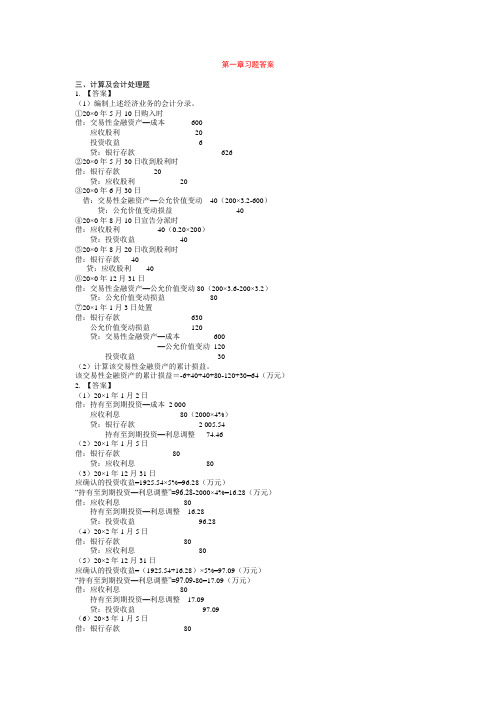
第一章习题答案三、计算及会计处理题1. 【答案】(1)编制上述经济业务的会计分录。
①20×0年5月10日购入时借:交易性金融资产—成本600应收股利20投资收益 6贷:银行存款626②20×0年5月30日收到股利时借:银行存款20贷:应收股利20③20×0年6月30日借:交易性金融资产—公允价值变动40(200×3.2-600)贷:公允价值变动损益40④20×0年8月10日宣告分派时借:应收股利40(0.20×200)贷:投资收益40⑤20×0年8月20日收到股利时借:银行存款40贷:应收股利40⑥20×0年12月31日借:交易性金融资产—公允价值变动80(200×3.6-200×3.2)贷:公允价值变动损益80⑦20×1年1月3日处置借:银行存款630公允价值变动损益120贷:交易性金融资产—成本600—公允价值变动120投资收益30(2)计算该交易性金融资产的累计损益。
该交易性金融资产的累计损益=-6+40+40+80-120+30=64(万元)2. 【答案】(1)20×1年1月2日借:持有至到期投资—成本 2 000应收利息80(2000×4%)贷:银行存款 2 005.54持有至到期投资—利息调整74.46(2)20×1年1月5日借:银行存款80贷:应收利息80(3)20×1年12月31日应确认的投资收益=1925.54×5%=96.28(万元)“持有至到期投资—利息调整”=96.28-2000×4%=16.28(万元)借:应收利息80持有至到期投资—利息调整16.28贷:投资收益96.28(4)20×2年1月5日借:银行存款80贷:应收利息80(5)20×2年12月31日应确认的投资收益=(1925.54+16.28)×5%=97.09(万元)“持有至到期投资—利息调整”=97.09-80=17.09(万元)借:应收利息80持有至到期投资—利息调整17.09贷:投资收益97.09(6)20×3年1月5日借:银行存款80贷:应收利息80(7)20×3年12月31日应确认的投资收益=(1941.82+17.09)×5%=97.95(万元)“持有至到期投资—利息调整”=97.95-80=17.95(万元)借:应收利息80持有至到期投资—利息调整17.95贷:投资收益97.95(8)20×4年1月5日借:银行存款80贷:应收利息80(9)20×4年12月31日“持有至到期投资—利息调整”=74.46-16.28-17.09-17.95=23.14(万元)应确认的投资收益=80+23.14=103.14(万元)借:应收利息80持有至到期投资—利息调整23.14贷:投资收益103.14(10)20×5年1月1日借:银行存款 2 080贷:持有至到期投资—成本 2 000应收利息803.【答案】(1)若将该债券划分为交易性金融资产,编制2008年与其有关的会计分录。
高财习题答案

第一篇企业合并与合并财务报表第一章企业合并与合并会计方法习题一、复习思考题(略)二、选择题1.B 2.A 3.B 4.C 5.C 6.ABC 7.AB 8.ABD 9.AD 10.AD三、业务题1.(1)编制P公司对S公司控股合并的会计分录。
借:长期股权投资 11 000贷:股本 1 000资本公积 10 000(2)编制P公司对S公司吸收合并的会计分录。
借:银行存款 200应收账款 800库存商品 4 000长期股权投资 1 000固定资产 8 000无形资产 1 000贷:短期借款 2 000应付账款 1 000其他应付款 1 000股本 1 000资本公积 10 0002.(1)编制合并日A公司对B公司进行控股合并的会计分录。
借:长期股权投资 10 000贷:股本 1 000资本公积 9 000(2)若A公司发行1600万股普通股(每股面值为1元,每股市价10元)对B公司进行吸收合并,并于当日取得B公司净资产。
编制A公司对B公司吸收合并的会计分录。
借:银行存款 200应收账款 800库存商品 5 000长期股权投资 1 500固定资产 9 500无形资产 2 000商誉 1 000贷:短期借款 2 000应付账款 1 000其他应付款 1 000股本 1 600资本公积 14 4003.作购买日A公司取得股权的会计分录;(没有考虑销项税金)借:长期股权投资 9 800贷:主营业务收入 5 000无形资产 2 000营业外收入 2 800借:主营业务成本 3 000贷:库存商品 3 000第二章合并财务报表的性质、合并范围与编制程序习题一、复习思考题(略)二、选择题1.A 2.B 3.ABC 4.ABC 5.ACD第三章同一控制下合并财务报表的编制习题一、复习思考题(略)二、选择题1.B 2.C 3.A 4.C 5.AB 6.BCD 7.B 8.B 9.ABD 10.CD 三、业务题1.合并日抵销调整分录如下:(1)借:实收资本(股本) 6 000资本公积 2 000盈余公积 300未分配利润 2 700贷:长期股权投资 11 000 (2)借:资本公积 3 000贷:盈余公积 300未分配利润 2 700合并资产负债表底稿(简表)2007年6月30日单位:万元2.(1)合并日A公司对B公司进行控股合并的会计分录抵销调整分录:借:长期股权投资 4800资本公积 1200贷:股本 6 000(2)A公司对B公司合并日的合并资产负债表抵销分录:①借:股本 3000资本公积 2000盈余公积 500未分配利润 2500贷:长期股权投资 4800少数股权 3200②借:资本公积 1800贷:盈余公积 300未分配利润 1500合并资产负债表底稿(简表)2006年12月31日单位:万元3.应用合并工作底稿编制2007年末合并资产负债表、合并利润表和合并所有者权益变动表。
高财课后练习及答案
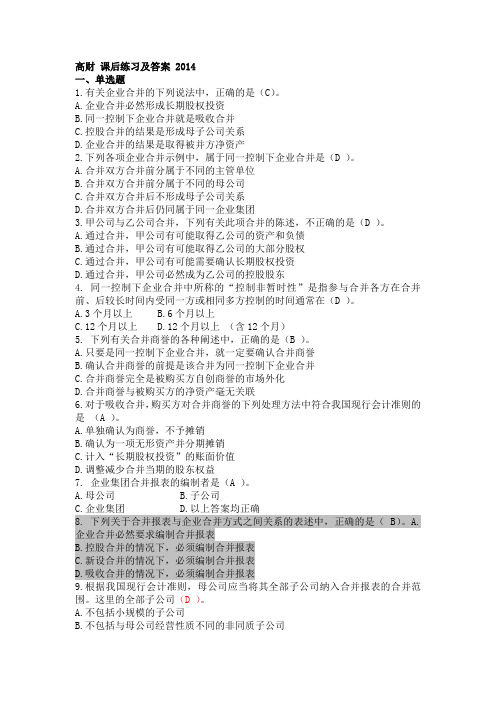
高财课后练习及答案 2014一、单选题1.有关企业合并的下列说法中,正确的是(C)。
A.企业合并必然形成长期股权投资B.同一控制下企业合并就是吸收合并C.控股合并的结果是形成母子公司关系D.企业合并的结果是取得被并方净资产2.下列各项企业合并示例中,属于同一控制下企业合并是(D )。
A.合并双方合并前分属于不同的主管单位B.合并双方合并前分属于不同的母公司C.合并双方合并后不形成母子公司关系D.合并双方合并后仍同属于同一企业集团3.甲公司与乙公司合并,下列有关此项合并的陈述,不正确的是(D )。
A.通过合并,甲公司有可能取得乙公司的资产和负债B.通过合并,甲公司有可能取得乙公司的大部分股权C.通过合并,甲公司有可能需要确认长期股权投资D.通过合并,甲公司必然成为乙公司的控股股东4. 同一控制下企业合并中所称的“控制非暂时性”是指参与合并各方在合并前、后较长时间内受同一方或相同多方控制的时间通常在(D )。
A.3个月以上B.6个月以上C.12个月以上D.12个月以上(含12个月)5. 下列有关合并商誉的各种阐述中,正确的是(B )。
A.只要是同一控制下企业合并,就一定要确认合并商誉B.确认合并商誉的前提是该合并为同一控制下企业合并C.合并商誉完全是被购买方自创商誉的市场外化D.合并商誉与被购买方的净资产毫无关联6.对于吸收合并,购买方对合并商誉的下列处理方法中符合我国现行会计准则的是(A )。
A.单独确认为商誉,不予摊销B.确认为一项无形资产并分期摊销C.计入“长期股权投资”的账面价值D.调整减少合并当期的股东权益7. 企业集团合并报表的编制者是(A )。
A.母公司B.子公司C.企业集团D.以上答案均正确8. 下列关于合并报表与企业合并方式之间关系的表述中,正确的是( B)。
A.企业合并必然要求编制合并报表B.控股合并的情况下,必须编制合并报表C.新设合并的情况下,必须编制合并报表D.吸收合并的情况下,必须编制合并报表9.根据我国现行会计准则,母公司应当将其全部子公司纳入合并报表的合并范围。
高财习题及答案

1.甲公司2008年5月1日以库存商品自丙公司手中换得乙公司60%的股权,甲公司、乙公司和丙公司同属一个企业集团,库存商品的成本为800 万元,公允价值为1000万元,增值税率为17%,消费税率为8%,该存货已提跌价准备为10 万元,当天乙公司账面净资产为700万元,公允净资产为1200 万元,当日甲公司资本公积结存额为240万元,全部为股本溢价,盈余公积结余额为360 万元,未分配利润结存额为1000万元。
编制甲公司取得投资时会计分录。
借:长期股权投资——乙公司(700×60%)420资本公积——股本溢价240盈余公积360利润分配——未分配利润20存货跌价准备10贷:库存商品800应交税费——应交增值税(销项税额)170——应交消费税802.甲公司2008 年10月1日定向增发普通股100万股给丙公司,从其手中换得乙公司60%的股权,甲公司与乙公司、丙公司无关联方关系,该股票每股面值为1 元,每股市价为10元,当天乙公司账面净资产为800 万元,公允净资产为2000 万元。
证券公司收取了45万元的发行费用。
编制甲公司取得投资的会计分录。
借:长期股权投资——乙公司1000贷:股本100 资本公积——股本溢价900同时,支付发行费用时:借:资本公积——股本溢价45贷:银行存款45 3、T 公司以一项原价1000万元、累计折旧400万元的设备和一项原价为600万元、累计摊销为150万元的专利权作为对价取得同一集团内另一家全资企业H 公司100%的股权,合并日H 公司所有者权益总量为1300万元,根据上述资料,编制会计分录。
借:长期股权投资1300累计折旧400累计摊销150贷:固定资产1000无形资产600资本公积2504.2008 年 2 月 1 日P 公司向 D 公司的股东定向增发1000 万股普通股(每股面值为1元),对D 公司进行合并,并于当日取得对 D 公司70%的股权,该普通股每股市场价格为4元,D 公司合并日可辨认净资产的公允价值为4500 万元,假定此合并为非同一控制下的企业合并,则P公司应认定的合并商誉为(850 )万元。
高财练习题
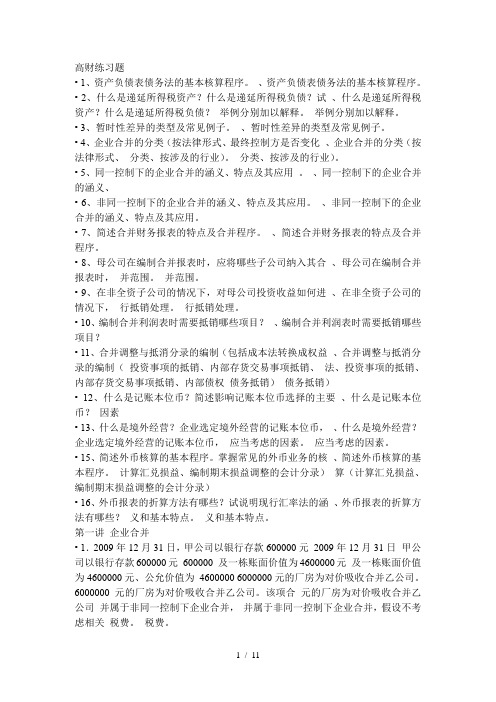
高财练习题• 1、资产负债表债务法的基本核算程序。
、资产负债表债务法的基本核算程序。
• 2、什么是递延所得税资产?什么是递延所得税负债?试、什么是递延所得税资产?什么是递延所得税负债?举例分别加以解释。
举例分别加以解释。
• 3、暂时性差异的类型及常见例子。
、暂时性差异的类型及常见例子。
• 4、企业合并的分类(按法律形式、最终控制方是否变化、企业合并的分类(按法律形式、分类、按涉及的行业)。
分类、按涉及的行业)。
• 5、同一控制下的企业合并的涵义、特点及其应用。
、同一控制下的企业合并的涵义、• 6、非同一控制下的企业合并的涵义、特点及其应用。
、非同一控制下的企业合并的涵义、特点及其应用。
• 7、简述合并财务报表的特点及合并程序。
、简述合并财务报表的特点及合并程序。
• 8、母公司在编制合并报表时,应将哪些子公司纳入其合、母公司在编制合并报表时,并范围。
并范围。
• 9、在非全资子公司的情况下,对母公司投资收益如何进、在非全资子公司的情况下,行抵销处理。
行抵销处理。
• 10、编制合并利润表时需要抵销哪些项目?、编制合并利润表时需要抵销哪些项目?• 11、合并调整与抵消分录的编制(包括成本法转换成权益、合并调整与抵消分录的编制(投资事项的抵销、内部存货交易事项抵销、法、投资事项的抵销、内部存货交易事项抵销、内部债权债务抵销)债务抵销)• 12、什么是记账本位币?简述影响记账本位币选择的主要、什么是记账本位币?因素• 13、什么是境外经营?企业选定境外经营的记账本位币,、什么是境外经营?企业选定境外经营的记账本位币,应当考虑的因素。
应当考虑的因素。
• 15、简述外币核算的基本程序。
掌握常见的外币业务的核、简述外币核算的基本程序。
计算汇兑损益、编制期末损益调整的会计分录)算(计算汇兑损益、编制期末损益调整的会计分录)• 16、外币报表的折算方法有哪些?试说明现行汇率法的涵、外币报表的折算方法有哪些?义和基本特点。
1,2,7-12章(财务管理学课后练习答案)1.doc

1,2,7-12章(财务管理学课后练习答案)1财务管理章后练习参考答案(王老师部分)第一章总论二、案例题答:(1)(一)以总产值最大化为目标缺点:1. 只讲产值,不讲效益;2. 只求数量,不求质量;3. 只抓生产,不抓销售;4. 只重投入,不重挖潜。
(二)以利润最大化为目标优点:企业追求利润最大化,就必须讲求经济核算,加强管理,改进技术,提高劳动生产率,降低产品成本。
这些措施都有利于资源的合理配置,有利于经济效益的提高。
缺点:1. 它没有考虑利润实现的时间,没有考虑资金时间价值;2. 它没能有效地考虑风险问题,这可能会使财务人员不顾风险的大小去追求最多的利润;3. 它往往会使企业财务决策带有短期行为的倾向,即只顾实现目前的最大利润,而不顾企业的长远发展。
(三)以股东财富最大化为目标优点:1. 它考虑了风险因素,因为风险的高低,会对股票价格产生重要影响;2. 它在一定程度上能够克服企业在追求利润上的短期行为,因为不仅目前的利润会影响股票价格,预期未来的利润也会对企业股票价格产生重要影响;3. 它比较容易量化,便于考核和奖惩。
缺点:1. 它只适用于上市公司,对非上市公司则很难适用;2. 它只强调股东的利益,而对企业其他关系人的利益重视不够;3. 股票价格受多种因素影响,并非都是公司所能控制的,把不可控因素引入理财目标是不合理的。
(四)以企业价值最大化为目标优点:1. 它考虑了取得报酬的时间,并用时间价值的原理进行了计量;2. 它科学地考虑了风险与报酬的关系;3. 它能克服企业在追求利润上的短期行为,因为不仅目前的利润会影响企业的价值,预期未来的利润对企业价值的影响所起的作用更大。
缺点:很难计量。
进行企业财务管理,就是要正确权衡报酬增加与风险增加的得与失,努力实现二者之间的最佳平衡,使企业价值达到最大化。
因此,企业价值最大化的观点,体现了对经济效益的深层次认识,它是现代企业财务管理目标的最优目标。
(2)青鸟天桥的财务管理目标是追求控股股东利益最大化。
高财 课后练习及答案
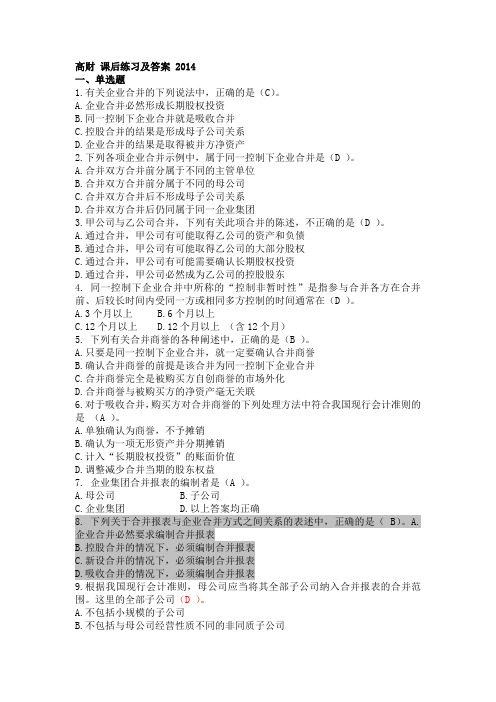
高财课后练习及答案 2014一、单选题1.有关企业合并的下列说法中,正确的是(C)。
A.企业合并必然形成长期股权投资B.同一控制下企业合并就是吸收合并C.控股合并的结果是形成母子公司关系D.企业合并的结果是取得被并方净资产2.下列各项企业合并示例中,属于同一控制下企业合并是(D )。
A.合并双方合并前分属于不同的主管单位B.合并双方合并前分属于不同的母公司C.合并双方合并后不形成母子公司关系D.合并双方合并后仍同属于同一企业集团3.甲公司与乙公司合并,下列有关此项合并的陈述,不正确的是(D )。
A.通过合并,甲公司有可能取得乙公司的资产和负债B.通过合并,甲公司有可能取得乙公司的大部分股权C.通过合并,甲公司有可能需要确认长期股权投资D.通过合并,甲公司必然成为乙公司的控股股东4. 同一控制下企业合并中所称的“控制非暂时性”是指参与合并各方在合并前、后较长时间内受同一方或相同多方控制的时间通常在(D )。
A.3个月以上B.6个月以上C.12个月以上D.12个月以上(含12个月)5. 下列有关合并商誉的各种阐述中,正确的是(B )。
A.只要是同一控制下企业合并,就一定要确认合并商誉B.确认合并商誉的前提是该合并为同一控制下企业合并C.合并商誉完全是被购买方自创商誉的市场外化D.合并商誉与被购买方的净资产毫无关联6.对于吸收合并,购买方对合并商誉的下列处理方法中符合我国现行会计准则的是(A )。
A.单独确认为商誉,不予摊销B.确认为一项无形资产并分期摊销C.计入“长期股权投资”的账面价值D.调整减少合并当期的股东权益7. 企业集团合并报表的编制者是(A )。
A.母公司B.子公司C.企业集团D.以上答案均正确8. 下列关于合并报表与企业合并方式之间关系的表述中,正确的是( B)。
A.企业合并必然要求编制合并报表B.控股合并的情况下,必须编制合并报表C.新设合并的情况下,必须编制合并报表D.吸收合并的情况下,必须编制合并报表9.根据我国现行会计准则,母公司应当将其全部子公司纳入合并报表的合并范围。
公司理财精要版原书第12版习题库答案Ross12e_Chapter12_TB
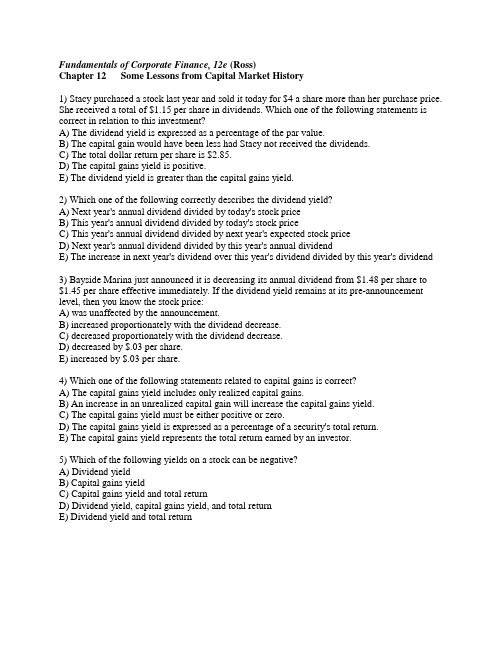
Fundamentals of Corporate Finance, 12e (Ross)Chapter 12 Some Lessons from Capital Market History1) Stacy purchased a stock last year and sold it today for $4 a share more than her purchase price. She received a total of $1.15 per share in dividends. Which one of the following statements is correct in relation to this investment?A) The dividend yield is expressed as a percentage of the par value.B) The capital gain would have been less had Stacy not received the dividends.C) The total dollar return per share is $2.85.D) The capital gains yield is positive.E) The dividend yield is greater than the capital gains yield.2) Which one of the following correctly describes the dividend yield?A) Next year's annual dividend divided by today's stock priceB) This year's annual dividend divided by today's stock priceC) This year's annual dividend divided by next year's expected stock priceD) Next year's annual dividend divided by this year's annual dividendE) The increase in next year's dividend over this year's dividend divided by this year's dividend3) Bayside Marina just announced it is decreasing its annual dividend from $1.48 per share to $1.45 per share effective immediately. If the dividend yield remains at its pre-announcement level, then you know the stock price:A) was unaffected by the announcement.B) increased proportionately with the dividend decrease.C) decreased proportionately with the dividend decrease.D) decreased by $.03 per share.E) increased by $.03 per share.4) Which one of the following statements related to capital gains is correct?A) The capital gains yield includes only realized capital gains.B) An increase in an unrealized capital gain will increase the capital gains yield.C) The capital gains yield must be either positive or zero.D) The capital gains yield is expressed as a percentage of a security's total return.E) The capital gains yield represents the total return earned by an investor.5) Which of the following yields on a stock can be negative?A) Dividend yieldB) Capital gains yieldC) Capital gains yield and total returnD) Dividend yield, capital gains yield, and total returnE) Dividend yield and total return6) Small-company stocks, as the term is used in the textbook, are best defined as the:A) 500 newest corporations in the U.S.B) companies whose stock trades OTC.C) smallest 20 percent of the companies listed on the NYSE.D) smallest 25 percent of the companies listed on NASDAQ.E) companies whose stock is listed on NASDAQ.7) The historical record for the period 1926–2016 supports which one of the following statements?A) When large-company stocks have a negative return, they will have a negative return for at least two consecutive years.B) The return on U.S. Treasury bills exceeds the inflation rate by at least .5 percent each year.C) There was only one year during the period when double-digit inflation occurred.D) Small-company stocks have lost as much as 50 percent and gained as much as 100 percent in a single year.E) The inflation rate was positive each year throughout the period.8) Which one of the following time periods is associated with low rates of inflation?A) 1941–1942B) 1973–1974C) 2014–2015D) 1979–1980E) 1946–19479) For the period 1926–2016, U.S. Treasury bills always:A) provided an annual rate of return that exceeded the annual inflation rate.B) had an annual rate of return in excess of 1.2 percent.C) provided a positive annual rate of return.D) earned a higher annual rate of return than long-term government bonds.E) had a greater variation in returns year-over-year than did long-term government bonds.10) Which one of the following statements is a correct reflection of the U.S. financial markets for the period 1926–2016?A) U.S. Treasury bill returns never exceeded a return of 9 percent in any one year.B) U.S. Treasury bills had an annual return in excess of 10 percent in three or more years.C) Inflation equaled or exceeded the return on U.S. Treasury bills every year during the period.D) Long-term government bonds outperformed U.S. Treasury bills every year during the period.E) National deflation occurred in at least one year during every decade during the period.11) For the period 2009–2016, U.S. Treasury bills had an annual rate of return that was:A) between .5 and 1 percent.B) between 1 and 2 percent.C) negative in at least one year.D) negative for two or more years.E) between 0 and .25 percent.12) Which one of the following categories of securities had the highest average annual return for the period 1926–2016?A) U.S. Treasury billsB) Large-company stocksC) Small-company stocksD) Long-term corporate bondsE) Long-term government bonds13) Which one of the following categories of securities had the lowest average risk premium for the period 1926–2016?A) Long-term government bondsB) Small-company stocksC) Large-company stocksD) Long-term corporate bondsE) U.S. Treasury bills14) The rate of return on which type of security is normally used as the risk-free rate of return?A) Long-term Treasury bondsB) Long-term corporate bondsC) Treasury billsD) Intermediate-term Treasury bondsE) Intermediate-term corporate bonds15) For the period 1926–2016, the average risk premium on large-company stocks was about:A) 12.7 percent.B) 10.4 percent.C) 8.6 percent.D) 6.9 percent.E) 7.3 percent.16) Assume that last year T-bills returned 2.8 percent while your investment in large-company stocks earned an average of 7.6 percent. Which one of the following terms refers to the difference between these two rates of return?A) Risk premiumB) Geometric average returnC) Arithmetic average returnD) Standard deviationE) Variance17) Which one of the following statements correctly applies to the period 1926–2016?A) Large-company stocks earned a higher average risk premium than did small-company stocks.B) The average inflation rate exceeded the average return on U.S. Treasury bills.C) Large-company stocks had an average annual return of 14.7 percent.D) Inflation averaged 2.6 percent for the period.E) Long-term corporate bonds outperformed long-term government bonds.18) The excess return is computed as the:A) return on a security minus the inflation rate.B) return on a risky security minus the risk-free rate.C) risk premium on a risky security minus the risk-free rate.D) risk-free rate plus the inflation rate.E) risk-free rate minus the inflation rate.19) Which one of the following earned the highest risk premium over the period 1926–2016?A) Long-term corporate bondsB) U.S. Treasury billsC) Small-company stocksD) Large-company stocksE) Long-term government bonds20) What was the average rate of inflation over the period of 1926–2016?A) Less than 2.0 percentB) Between 2.0 and 2.4 percentC) Between 2.4 and 2.8 percentD) Between 2.8 and 3.2 percentE) Greater than 3.2 percent21) Assume you invest in a portfolio of long-term corporate bonds. Based on the period 1926–2016, what average annual rate of return should you expect to earn?A) Less than 5 percentB) Between 5 and 6 percentC) Between 6 and 7 percentD) Between 7 and 8 percentE) More than 8 percent22) The average annual return on small-company stocks was about ________ percent greater than the average annual return on large-company stocks over the period 1926–2016.A) 3B) 5C) 7D) 9E) 1123) Based on the period 1926-2016, the actual real return on large-company stocks has been around:A) 9 percent.B) 10 percent.C) 6 percent.D) 7 percent.E) 8 percent.24) To convince investors to accept greater volatility, you must:A) decrease the risk premium.B) increase the risk premium.C) decrease the real return.D) decrease the risk-free rate.E) increase the risk-free rate.25) Which one of the following best defines the variance of an investment's annual returns over a number of years?A) The average squared difference between the arithmetic and the geometric average annual returnsB) The squared summation of the differences between the actual returns and the average geometric returnC) The average difference between the annual returns and the average return for the periodD) The difference between the arithmetic average and the geometric average return for the periodE) The average squared difference between the actual returns and the arithmetic average return26) Which one of the following categories of securities had the most volatile annual returns over the period 1926–2016?A) Long-term corporate bondsB) Large-company stocksC) Intermediate-term government bondsD) U.S. Treasury billsE) Small-company stocks27) If the variability of the returns on large-company stocks were to decrease over the long-term, you would expect which one of the following as related to large-company stocks to occur as a result?A) Increase in the risk premiumB) Increase in the average long-term rate of returnC) Decrease in the 68 percent probability range of returnsD) Increase in the standard deviationE) Increase in the geometric average rate of return28) Which one of the following statements is correct based on the historical record for the period 1926–2016?A) The standard deviation of returns for small-company stocks was double that of large-company stocks.B) U.S. Treasury bills had a zero standard deviation of returns because they are considered to be risk-free.C) Long-term government bonds had a lower return but a higher standard deviation on average than did long-term corporate bonds.D) Inflation was less volatile than the returns on U.S. Treasury bills.E) Long-term government bonds were less volatile than intermediate-term government bonds.29) What is the probability that small-company stocks will produce an annual return that is more than one standard deviation below the average?A) 1.0 percentB) 2.5 percentC) 5.0 percentD) 16 percentE) 32 percent30) Which one of the following is a correct ranking of securities based on the volatility of their annual returns over the period of 1926–2016? Rank from highest to lowest.A) Large-company stocks, U.S. Treasury bills, long-term government bondsB) Small-company stocks, long-term corporate bonds, large-company stocksC) Long-term government bonds, long-term corporate bonds, intermediate-term government bondsD) Large-company stocks, small-company stocks, long-term government bondsE) Intermediate-term government bonds, long-term corporate bonds, U.S. Treasury bills31) Which one of the following had the least volatile annual returns over the period of 1926–2016?A) Large-company stocksB) InflationC) Long-term corporate bondsD) U.S. Treasury billsE) Intermediate-term government bonds32) Which one of the following statements is correct based on the period 1926–2016?A) Long-term government bonds had more volatile annual returns than did the long-term corporate bonds.B) The standard deviation of the annual rate of inflation was less than 3 percent.C) U.S Treasury bills have a zero variance in returns because they are risk-free.D) The risk premium on small-company stocks was less than 10 percent.E) The risk premium on all U.S. government securities is 0 percent.33) Generally speaking, which of the following best correspond to a wide frequency distribution?A) High standard deviation, low rate of returnB) Low rate of return, large risk premiumC) Small risk premium, high rate of returnD) Small risk premium, low standard deviationE) High standard deviation, large risk premium34) Standard deviation is a measure of which one of the following?A) Average rate of returnB) VolatilityC) ProbabilityD) Risk premiumE) Real returns35) Which one of the following is defined by its mean and its standard deviation?A) Arithmetic nominal returnB) Geometric real returnC) Normal distributionD) VarianceE) Risk premium36) Which of the following statements are true based on the historical record for 1926–2016?A) Risk-free securities produce a positive real rate of return each year.B) Bonds are generally a safer, or less risky, investment than are stocks.C) Risk and potential reward are inversely related.D) The normal distribution curve for large-company stocks is narrower than the curve for small-company stocks.E) Returns are more predictable over the short term than they are over the long term.37) Estimates of the rate of return on a security based on the historical arithmetic average will probably tend to ________ the expected return for the long-term and estimates using the historical geometric average will probably tend to ________ the expected return for the short-term.A) overestimate; overestimateB) overestimate; underestimateC) underestimate; overestimateD) underestimate; underestimateE) accurately estimate; accurately estimate38) The primary purpose of Blume's formula is to:A) compute an accurate historical rate of return.B) determine a stock's true current value.C) consider compounding when estimating a rate of return.D) determine the actual real rate of return.E) project future rates of return.39) The average compound return earned per year over a multiyear period is called the ________ average return.A) arithmeticB) standardC) variantD) geometricE) real40) The return earned in an average year over a multiyear period is called the ________ average return.A) arithmeticB) standardC) variantD) geometricE) real41) Assume all stock prices fairly reflect all of the available information on those stocks. Which one of the following terms best defines the stock market under these conditions?A) Riskless marketB) Evenly distributed marketC) Zero volatility marketD) Blume's marketE) Efficient capital market42) Which one of the following statements best defines the efficient market hypothesis?A) Efficient markets limit competition.B) Security prices in efficient markets remain steady as new information becomes available.C) Mispriced securities are common in efficient markets.D) All securities in an efficient market are zero net present value investments.E) All securities provide the same positive rate of return when the market is efficient.43) Which one of the following is the most likely reason why a stock price might not react at all on the day that new information related to the stock's issuer is released? Assume the market is semistrong form efficient.A) Company insiders were aware of the information prior to the announcement.B) Investors do not pay attention to daily news.C) Investors tend to overreact.D) The news was positive.E) The information was expected.44) Which one of the following is most indicative of a totally efficient stock market?A) Extraordinary returns earned on a routine basisB) Positive net present values on stock investments over the long-termC) Zero net present values for all stock investmentsD) Arbitrage opportunities which develop on a routine basisE) Realizing negative returns on a routine basis45) Which one of the following statements is correct concerning market efficiency?A) Real asset markets are more efficient than financial markets.B) If a market is efficient, arbitrage opportunities should be common.C) In an efficient market, some market participants will have an advantage over others.D) A firm will generally receive a fair price when it issues new shares of stock if the market is efficient.E) New information will gradually be reflected in a stock's price to avoid any sudden price changes in an efficient market.46) Efficient financial markets fluctuate continuously because:A) the markets are continually reacting to old information as that information is absorbed.B) the markets are continually reacting to new information.C) arbitrage trading is limited.D) current trading systems require human intervention.E) investments produce varying levels of net present values.47) Inside information has the least value when financial markets are:A) weak form efficient.B) semiweak form efficient.C) semistrong form efficient.D) strong form efficient.E) inefficient.48) Evidence seems to support the view that studying public information to identify mispriced stocks is:A) effective as long as the market is only semistrong form efficient.B) effective provided the market is only weak form efficient.C) ineffective.D) effective only in strong form efficient markets.E) ineffective only in strong form efficient markets.49) Which one of the following statements related to market efficiency tends to be supported by current evidence?A) It is easy for investors to earn abnormal returns.B) Short-run price movements are easy to predict.C) Markets are most likely only weak form efficient.D) Mispriced stocks are easy to identify.E) Markets tend to respond quickly to new information.50) Which form of market efficiency would most likely offer the greatest profit potential to an outstanding professional stock analyst?A) WeakB) SemiweakC) SemistrongD) StrongE) Perfect51) You are aware that your neighbor trades stocks based on confidential information he overhears at his workplace. This information is not available to the general public. This neighborcontinually brags to you about the profits he earns on these trades. Given this, you would tend to argue that the financial markets are at best ________ form efficient.A) weakB) semiweakC) semistrongD) strongE) perfect52) The U.S. Securities and Exchange Commission periodically charges individuals with insider trading and claims those individuals have made unfair profits. Given this, you would be most apt to argue that the markets are less than ________ form efficient.A) weakB) semiweakC) semistrongD) strongE) perfect53) Individual investors who continually monitor the financial markets seeking mispriced securities:A) earn excess profits on all of their investments.B) make the markets increasingly more efficient.C) are never able to find a security that is temporarily mispriced.D) are overwhelmingly successful in earning abnormal profits.E) are always quite successful using only historical price information as their basis of evaluation.54) One year ago, you purchased a stock at a price of $43.20 per share. The stock pays quarterly dividends of $.18 per share. Today, the stock is selling for $45.36 per share. What is your capital gain on this investment?A) $1.44B) $2.16C) $2.80D) $1.74E) $2.3455) Six months ago, you purchased 300 shares of stock in Global Trading at a price of $26.19 a share. The stock pays a quarterly dividend of $.12 a share. Today, you sold all of your shares for $27.11 per share. What is the total amount of your dividend income on this investment?A) $36B) $72C) $348D) $144E) $20456) One year ago, you purchased 200 shares of SL Industries stock at a price of $18.97 a share. The stock pays an annual dividend of $1.42 per share. Today, you sold all of your shares for $17.86 per share. What is your total dollar return on this investment?A) $50B) $91C) $58D) $62E) $8257) You own 850 shares of Western Feed Mills stock valued at $53.15 per share. What is the dividend yield if your total annual dividend income is $1,256?A) 2.67 percentB) 2.78 percentC) 1.83 percentD) 2.13 percentE) 2.54 percent58) West Wind Tours stock is currently selling for $52.30 a share. The stock has a dividend yield of 2.48 percent. How much dividend income will you receive per year if you purchase 600 shares of this stock?A) $824.96B) $836.20C) $724.80D) $762.00E) $778.2259) One year ago, you purchased a stock at a price of $38.22 a share. Today, you sold the stock and realized a total loss of 11.09 percent on your investment. Your capital gain was –$4.68 a share. What was your dividend yield?A) 1.15 percentB) .88 percentC) 1.02 percentD) .67 percentE) .38 percent60) You just sold 427 shares of stock at a price of $19.07 a share. You purchased the stock for $18.83 a share and have received total dividends of $614. What is the total capital gain on this investment?A) $716.48B) $511.52C) $102.48D) $618.48E) $476.5261) Last year, you purchased 400 shares of Analog stock for $12.92 a share. You have received a total of $136 in dividends and $4,301 in proceeds from selling the shares. What is your capital gains yield on this stock?A) 9.09 percentB) 6.73 percentC) −16.78 percentD) −14.14 percentE) −11.02 percent62) Today, you sold 540 shares of stock and realized a total return of 7.3 percent. You purchased the shares one year ago at a price of $24 a share and have received a total of $86 in dividends. What is your capital gains yield on this investment?A) 5.68 percentB) 6.64 percentC) 6.39 percentD) 7.26 percentE) 7.41 percent63) Four months ago, you purchased 900 shares of LBM stock for $7.68 a share. Last month, you received a dividend payment of $.12 a share. Today, you sold the shares for $9.13 a share. What is your total dollar return on this investment?A) $1,305B) $1,413C) $1,512D) $1,394E) $1,08064) One year ago, you purchased 100 shares of Best Wings stock at a price of $38.19 a share. The company pays an annual dividend of $.46 per share. Today, you sold for the shares for $37.92 a share. What is your total percentage return on this investment?A) 2.62 percentB) 1.93 percentC) 2.72 percentD) 1.08 percentE) .50 percent65) Suppose a stock had an initial price of $76 per share, paid a dividend of $1.42 per share during the year, and had an ending share price of $81. What was the capital gains yield?A) 6.17 percentB) 6.69 percentC) 7.05 percentD) 6.58 percentE) 5.44 percent66) Suppose you bought a $1,000 face value bond with a coupon rate of 5.6 percent one year ago. The purchase price was $987.50. You sold the bond today for $994.20. If the inflation rate last year was 2.6 percent, what was your exact real rate of return on this investment?A) 4.88 percentB) 5.32 percentC) 3.65 percentD) 3.78 percentE) 4.47 percent67) Leo purchased a stock for $63.80 a share, received a dividend of $2.68 a share and sold the shares for $59.74 each. During the time he owned the stock, inflation averaged 2.8 percent. What is his approximate real rate of return on this investment?A) −.64 percentB) −4.96 percentC) −2.16 percentD) 2.16 percentE) 4.96 percent68) Christina purchased 500 shares of stock at a price of $62.30 a share and sold the shares for $64.25 each. She also received $738 in dividends. If the inflation rate was 3.9 percent, what was her exact real rate of return on this investment?A) 4.20 percentB) 1.54 percentC) 1.60 percentD) 3.95 percentE) 5.50 percent69) What is the amount of the risk premium on a U.S. Treasury bill if the risk-free rate is 3.1 percent, the inflation rate is 2.6 percent, and the market rate of return is 7.4 percent?A) 0 percentB) 2.8 percentC) .5 percentD) 1.7 percentE) 4.3 percent70) You've observed the following returns on Crash-n-Burn Computer's stock over the past five years: 7 percent, 13 percent, 19 percent, −8 percent, and 15 percent. Suppose the average inflation rate over this time period was 2.6 percent and the average T-bill rate was 3.1 percent. Based on this information, what was the average nominal risk premium?A) 6.6 percentB) 6.1 percentC) 9.2 percentD) 1.2 percentE) 3.5 percent71) You bought one of Shark Repellant's 6 percent coupon bonds one year ago for $867. These bonds pay annual payments, have a face value of $1,000, and mature 12 years from now. Suppose you decide to sell your bonds today when the required return on the bonds is 7.4 percent. The inflation rate over the past year was 2.9 percent. What was your total real return on this investment?A) 6.48 percentB) 6.61 percentC) 8.18 percentD) 7.44 percentE) 9.70 percent72) You find a certain stock that had returns of 8 percent, −3 percent, 12 percent, and 17 percent for four of the last five years. The average return of the stock for the past five-year period was 6 percent. What is the standard deviation of the stock's returns for the five-year period?A) 10.39 percentB) 4.98 percentC) 7.16 percentD) 9.25 percentE) 5.38 percent73) A stock had returns of 5 percent, 14 percent, 11 percent, −8 percent, and 6 percent over the past five years. What is the standard deviation of these returns?A) 7.74 percentB) 8.21 percentC) 9.68 percentD) 8.44 percentE) 7.49 percent74) The common stock of Air Express had annual returns of 11.7 percent, 8.8 percent,16.7 percent, and −7.9 percent over the last four years, respectively. What is thestandard deviation of these returns?A) 8.29 percentB) 9.14 percentC) 11.54 percentD) 7.78 percentE) 10.66 percent75) A stock had annual returns of 5.3 percent, −2.7 percent, 16.2 percent, and 13.6 percentover the past four years. Which one of the following best describes the probability that this stock will produce a return of 20 percent or more in a single year?A) Less than 2.5 percent but more than .5 percentB) More than 16 percentC) Less than .5 percentD) Less than 1 percent but more than .5 percentE) Less than 16 percent but more than 2.5 percent76) A stock has an expected rate of return of 9.8 percent and a standard deviation of 15.4 percent. Which one of the following best describes the probability that this stock will lose at leasthalf of its value in any one given year?A) less than 16 percentB) less than .5 percentC) less than 1.0 percentD) less than 2.5 percentE) less than 5.0 percent77) A stock had annual returns of 11.3 percent, 9.8 percent, −7.3 percent, and 14.6percent for the past four years. Based on this information, what is the 95 percentprobability range of returns for any one given year?A) −2.4 to 17.5 percentB) −2.60 to 11.80 percentC) −12.5 to 26.7 percentD) −10.4 to 12.3 percentE) −10.9 to 25.1 percent78) Aimee is the owner of a stock with annual returns of 17.6 percent, −11.7 percent, 5.6 percent, and 9.7 percent for the past four years. She thinks the stock may achieve a returnof 17 percent again this coming year. What is the probability that your friend is correct?A) Less than .5 percentB) Greater than .5 percent but less than 1 percentC) Greater than 1 percent but less than 2.5 percentD) Greater than 2.5 percent but less than 16 percentE) Greater than 16 percent79) A stock had returns of 3 percent, 12 percent, 26 percent, −14 percent, and −1 percent for the past five years. Based on these returns, what is the approximate probability that this stock will return at least 20 percent in any one given year?A) Approximately .1 percentB) Approximately 5 percentC) Approximately 2.5 percentD) Approximately .5 percentE) Approximately 16 percent80) A stock had returns of 14 percent, 13 percent, −10 percent, and 7 percent for thepast four years. Which one of the following best describes the probability that this stockwill lose no more than 10 percent in any one year?A) Greater than .5 but less than 1.0 percentB) Greater than 1 percent but less than 2.5 percentC) Greater than 2.5 percent but less than 16 percentD) Greater than 84 percent but less than 97.5 percentE) Greater than 95 percent。
- 1、下载文档前请自行甄别文档内容的完整性,平台不提供额外的编辑、内容补充、找答案等附加服务。
- 2、"仅部分预览"的文档,不可在线预览部分如存在完整性等问题,可反馈申请退款(可完整预览的文档不适用该条件!)。
- 3、如文档侵犯您的权益,请联系客服反馈,我们会尽快为您处理(人工客服工作时间:9:00-18:30)。
第一章企业合并(一)单项选择题1.企业合并是指将两个或者两个以上单独的企业合并形成一个()的交易或事项。
A.法律主体B.会计主体C.报告主体D.合并主体2.第五次兼并浪潮的特点是()。
A.多元合并B.纵向兼并C.融资兼并D.战略兼并3.()是企业合并的具体动因之一。
A.企业经营不善,资不抵债,无法继续经营B.实现财务协同作用C.缺乏现代经营管理理念,内部控制制度不健全D.不能及时调整产业结构、人才结构4.达到最佳经济规模的要求,实现规模最经济,是()的要求。
A.实现财务协同作用B.扩大市场份额C.多种经营,规避市场风险D.实现产销经营活动的协同作用5.公司通过现金购买、股票交换或发行债务性证券等形式,取得另一个公司的部分或全部的有表决权的股份而进行的合并,是()。
A.控股合并B.纵向合并C.新设合并D.吸收合并6.同一控制下的企业合并是指参与合并的企业在合并前后均受()最终控制且该控制并非暂时性的。
A.生产前后连续性的企业之间B.相同的多方C.生产或经营同类产品及劳务的企业D.工艺上无关联的企业间7.()是把企业合并看成是一个企业购买另一个被合并企业或几个被合并企业净资产的交易行为,购买企业获得对被购买企业净资产的控制权和经营权。
A.权益联营法B.股权集中法C.购买法D.权益结合法8.对于同一控制下的企业合并,企业合并准则中规定的会计处理方法是()。
A.权益结合法B.成本法C.购买法D.权益法9.同一控制下企业合并,在根据合并差额调整合并方的所有者权益时,应首先调整()。
A.实收资本B.留存收益C.所有者权益D.资本公积10.甲、乙公司属于同一母公司控制下的两家子公司。
2009年6月04日,甲公司以账面价值为7 000万元、公允价值为6600万元的厂房作为对价,取得乙公司80%的股权,相关手续已办理;当日乙公司账面净资产总额为8 000万元、公允价值为8 500万元。
2009年8月05日,乙公司宣告发放2008年度现金股利800万元。
假定不考虑其他因素影响。
2009年6月04日,甲公司对乙公司长期股权投资的账面价值为()万元。
A.5600 B.5280C.6400 D.680011.甲、乙公司不属于同一控制下的公司。
2009年7月15日,甲公司以存货和承担乙公司短期借款的偿还义务的方式取得乙公司的80%的股权。
合并当日乙公司可辨认净资产的公允价值为800万,甲公司投出存货的公允价值为400万,账面价值为350万,增值税率为17%。
承担还款义务300万。
则甲公司的合并成本为()万。
A.768 B.468C.700 D.65012.A企业于2007年2月17日聘请会计师事务所对B公司进行资产评估,于2007年6月5日取得B公司30%的股权(假定能够对被投资单位施加重大影响),后又于2008年12月2日召开股东大会,表决通过再次收购B公司股份的决议,于2009年3月21日再次取得B公司30%的股权,并于当日对B公司实施控制。
企业合并的购买日是()。
A.2007年2月17日B.2007年6月5日C.2008年12月2日D.2009年3月21日13.A公司于2008年2月以4000万元取得B公司40%的股份,取得投资时B公司净资产的公允价值为35000万元。
2008年底,确认对B公司的投资收益120万元。
2009年6月,A公司另支付4500万元取得B公司另外40%的股份,能够对B公司实施控制。
B公司自2008年A公司取得投资后至2009年购买进一步股份前实现的留存收益为1250万元,未进行利润分配。
则2009年6月,A公司再次投资后,对B公司长期股权投资的账面价值为()万元。
A.4000 B.4500C.8500 D.800014.在非同一控制下的企业合并中,企业合并成本低于取得的被购买方可辨认净资产公允价值份额之间的差额,应()。
A.确认为商誉B.计入合并当期的营业外收入C.冲减合并成本D.不做会计处理15.甲公司和乙公司不属于同一控制的两个公司,2009年1月1日,甲公司以一台固定资产和银行存款500万元向乙公司投资,占乙公司注册资本的50%,该固定资产的账面原价为6000万元,已计提累计折旧1000万元,已计提固定资产减值准备300万元,公允价值为5000万元。
不考虑其他相关税费。
则甲公司计入营业外收入的金额为()。
A.300 B.4700C.5500 D.500016.非同一控制下企业合并中发生的与企业合并直接相关的费用,应()。
A.计入当期损益B.计入企业合并成本C.冲减资本公积D.冲减留存收益17.在非同一控制企业合并中,发行权益性证券作为合并对价的,与所发行权益性证券相关的佣金、手续费等,应()。
A.自所发行权益性证券的发行溢价收入中扣除B.直接计入当期损益C.直接冲减留存收益D.计入合并成本18.在非同一控制企业合并中,付出资产公允价值与账面价值的差额应()。
A.计入资本公积——其他资本公积B.计入资本公积——股本溢价C.列为间接费用D.计入当期损益19.若参与合并的企业的会计处理方法不一致,应进行追溯调整,是()的特点。
A.购买法B.非同一控制企业合并C.控股合并D.权益结合法20.()会削弱企业间的竞争,改善行业结构,并在很多情况下形成垄断。
A.同一控制下的企业合并B.混合合并C.横向合并D.吸收合并(二)多项选择题1.认定企业合并取决于两个关键因素,即()和()。
A.控制权的转移B.公司名称的改变C.企业法人的改变D.报告主体的变化2.企业合并的具体动因,主要有()几个方面。
A.扩大市场份额B.实现财务协同作用C.企业发展的动机D.多种经营,规避市场风险3.企业合并按法律形式划分可分()。
A.吸收合并B.横向合并C.控股合并D.同一控制下的企业合并4.控股合并的优势是()。
A.不需要取得附属公司全部有表决权的股份,就可以实现对附属公司的控制B.可以取得另一个或另几个公司的全部净资产C.节约合并成本D.合并风险较小5.一般企业的合并业务程序根据有关法规,有以下()步骤。
A.进行资产评估B.可行性研究和科学论证C.通知或公告债权人并进行债权登记,债权人向清算组申报其债权。
D.办理产权交接手续6.购买法的特点是()。
A.公允价值记账B.商誉应在企业发生合并业务时加以确认,按规定进行减值测试。
C.被合并企业的合并前利润并入购买企业的利润中。
D.合并时的直接相关费用增加合并成本,合并的间接费用列为当期费用。
7.权益结合法的特点是()。
A.购买企业的留存利润有可能因合并而减少,但不能增加B.企业合并时,直接相关和间接费用,均在发生时确认为当期费用C.参与合并的企业的净资产均按照账面价值计价,不考虑净资产的公允价值D.参与合并的企业整个年度的损益和留存收益全部包含在合并后的企业中8.合并方为进行企业合并发生的各项直接相关费用,包括()。
A.为进行企业合并支付的审计费用B.资产评估费用C.与发行债券相关的佣金、手续费D.法律咨询费用9.发行权益性证券作为合并对价的,在权益性证券发行无溢价或溢价金额不足以扣减的情况下,应当冲减()。
A.盈余公积B.资本公积C.实收资本D.未分配利润10.甲公司和乙公司为非同一控制下的两家公司。
甲公司以一项账面价值为220万元的设备(原价250万元,累计折旧30 万元)和一项账面价值为350万元的商标权为对价取得同母公司控制下另一家子公司(乙公司)100%的股权,合并过程中发生审计、评估费等直接相关费用20万元。
合并日,甲公司和乙公司所有者权益构成如下表所示, 甲公司资本公积全部属于股本溢价:单位:元根据上述资料,下列说法中正确的有()。
A.乙公司在合并前实现的留存收益中归属于甲公司的部分转入留存收益应冲减资本公积的金额为300万元B.企业合并时应确认资本公积的金额为30万元C.进行企业合并以后,甲公司资本公积-股本溢价的余额为250万元D.合并过程中发生的审计、评估费等直接相关费用应该计入长期股权投资的初始入账价值11.A公司和B公司为同一集团控制下的两家子公司,2009年10月25日,A公司以银行存款620万元取得B公司所有者权益的55%,合并当日B公司所有者权益的账面价值为1000万元,可辨认净资产公允价值为1300万元。
则A 公司在合并日的会计处理中,正确的是()。
A.应确认资本公积——资本溢价70万元B.应确认资本公积——其他资本公积70万元C.应确认资本公积——其他资本公积95万元D.确认的资本公积金额应在会计科目借方12.长期股权投资采用权益法核算时,初始投资成本大于应享有被投资单位可辨认资产公允价值份额之间的差额,下列会计处理不正确的是()。
A.计入投资收益B.不调整初始投资成本C.计入营业外支出D.冲减资本公积13.关于长期股权投资成本法核算,下列说法正确的有()。
A.期末计提减值准备,减值准备可以转回B.期末计提减值准备,减值准备一经计提不得转回C.适用范围是对被投资单位持有的表决权资本比例需在5%以下D.以支付的全部价款作为初始投资成本入账,已宣告尚未领取的现金股利除外14.同一控制下的企业合并会计处理的特点是()。
A.企业合并成本大于合并中取得的被购买方可辨认净资产公允价值份额的差额,应确认为商誉B.合并中不产生新的资产和负债C.合并方应当按照本企业会计政策对被合并方资产、负债的账面价值进行调整D.取得的净资产按照账面价值并入合并方15.非同一控制下企业合并会计处理的特点是()。
A.非同一控制下企业合并中发生的与企业合并直接相关的费用,应当计入企业合并成本。
B.对于购买方在企业合并时可能需要代被购买方承担的或有负债,在其公允价值能够合理确定的情况下,即需要作为合并中取得的负债确认。
C.企业合并成本小于合并中取得的被购买方可辨认净资产公允价值份额的差额,应计入合并当期损益。
D.在无形资产的公允价值能够可靠计量的情况下,应区别于商誉单独确认的无形资产。
(三)判断题1.企业合并是指将两个或者两个以上单独的企业合并形成一个法律主体的交易或事项。
()2.协同作用就是1 + 1 > 2的效应。
表现在企业合并是指将两个或者两个以上单独的企业合并形成一个报告主体的交易或事项。
()3.新设合并也称为创立合并,是指一个公司通过现金购买、股票交换或发行债务性证券等形式,取得另一个公司的部分或全部的有表决权的股份而进行的合并。
()4.同一控制下的企业合并是指参与合并的企业在合并前后均受同一方或相同的多方最终控制且该控制并非暂时性的。
()5.同一控制下的企业合并是合并各方自愿进行的交易行为,其交易更具公平性。
()6.购买法下,合并成本超过所取得的被合并企业可辨认净资产公允价值份额的差额需要调整资本公积。
()7.购买法下,购买企业的利润不仅包括当年本身实现的利润以及合并日后被合并企业所实现的利润,被合并企业的合并前利润也应并入购买企业的利润中。
